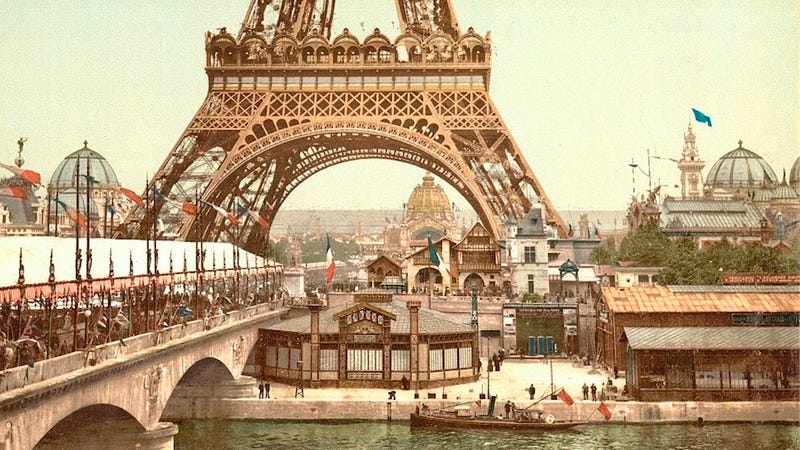Как Всемирная ярмарка в Париже двинула арт-нуво в массы

The Paris World's Fair of 1900 (also known as The Exposition Universelle) was held in Paris between 15 April and 12 November. On display were many new inventions: matryoshka dolls, Diesel engines, talking film, and the telegraphone. But more importantly, the architecture and design of this World's Fair broughtthe wonderful Art Nouveau style into popular culture. These photos and illustrations of the Fair show why the world fell in love with Art Nouveau.
Why Budapest Is Famous For Its Art Nouveau Architecture
The Art Noveau ("New Art" in French) was a popular style of art between 1890 and 1910,… Read more on io9.com
A view of the Exposition Universelle
The Eiffel Tower with the Globe Céleste, the icon of the Exposition Universelle
Crowds arriving at the Place de la Concorde on double deck cars, the monumental gate by Binet
The Grand Entrance
Ancient Paris, a recreation of the medieval Paris and the Palais of the Land and Sea Forces on the other side of the river
The illuminated Eiffel Tower, erected in 1889 as the entrance arch to a previous World's Fair
The Chateau of Water, Palace of Electricity and Palace of Chemical Industries, as seen from and under the Eiffel Tower
The Avenue Nicholas II
The Avenue Nicholas II, looking towards the Dome of the Invalides
The environs of the Trocadero
The Palace Lumineux
Champ de Mars
A road between pavilions
The national pavilions
Belgium (left) and Finland (right)
Germany (left and below) and Sweden (right)
Italy
Russia
The Austro-Hungarian Pavilion
United States
The Dutch East Indies Pavilion, a replica of Candi Sari, a 8th-century Buddhist temple in Indonesia
Algeria
Norway
(via Societe Anglaise)
Romania
(via Modernism)
Indo-China
(via Exposition Universelle 1900 and belleindochine)
The Le Tour du Monde pavilions displaying a collection of exotic oriental architectures – a Siamese pavilion, a Japanese pagoda and an Indian pavilion.
(via Boston College)
Cambodia
Sudan and Senegal
(via Brown University)
The Grand and the Little Palace
A Perfumery in the Department of Chemistry
Inside the Palace of Electricity
Inside the La Salle des Fêtes
The Palace of Optics
Manufacturer's and Liberal Arts Building
Commercial Navigation Building and Quai d' Orsay, France
The Commercial Navigation, Industrial Arts, Electrical sections and the main hall in the United States Pavilion
A sculpture exhibition at the Grand Palace
(via Brown University)
The Palace of Horticulture
The Agricultural Section with the shop of Chocolat Menier
Palace of Forestry, Hunting, Fishing and Gathering
Inside the Hungarian Pavilion
Palace of Decorative Arts with glass items of Crystallerie de la Pantin, a well-known glass maker
A giant telescope in the Palace of Optics
(via Wikimedia Commons 1 – 2)
Cinéorama, an early film experiment by Raoul Grimoin-Sanson. It simulated a ride in a hot air balloon over Paris.
The system consisted ten 70mm movie projectors and a 90x9 (295x29.5 ft) metre screens.
It lasted only three days, because it was shut down by the police for safety reasons: the projectors lights caused extreme heat.
(via Wikimedia Commons)
A moving sidewalk
Moving Sidewalk Mechanics (1900)
Edison's film from the 1900 Paris Exposition is amazing, but it leaves you wondering how that… Read more on paleofuture.gizmodo.com
A rolling platform 30 ft. above head with steel rails and the sidewalk
(via Brown University)
________________________
The photos above are from Brooklyn Museum and The Library of Congress, made by Henry William Goodyear, except when noted otherwise.
0 комментариев